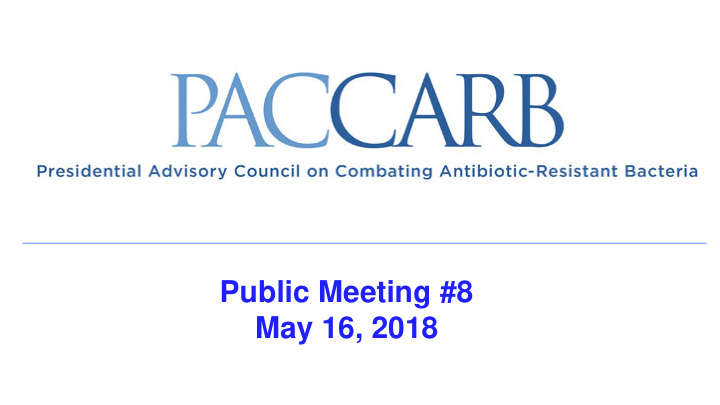



Mark G. Papich, Professor Public Meeting #8 North Carolina State University College of Veterinary Medicine May 16, 2018 Raleigh, North Carolina mark_papich@ncsu.edu
Referral Institution Prescribing Behavior Mark G. Papich North Carolina State University College of Veterinary Medicine Raleigh, North Carolina mark_papich@ncsu.edu
Differences Between Veterinary Practices General Practice Referral Hospitals (Specialty Practice) • Veterinarians with advanced specialty training • Veterinarians engaged in • Located at veterinary colleges and general practice private hospitals • Routine diagnosis & treatment • Sites for training students and other • Complicated cases are specialists referred to specialty practices • Typically see more complicated cases
Differences Between Patients Referral General Practice Hospitals • Complicated cases • General health & wellness visits • In most cases, patients have • Routine treatment & surgery already been prescribed • Infections tend to be “routine” antibiotics • Infections tend to be more complicated and resistant
What influences our antibiotic selections?
Studies on Antibiotic Prescribing in Referral Hospitals / University Hospitals Jacob et al. Opinions of clinical veterinarians at a US veterinary teaching hospital regarding antimicrobial use and antimicrobial- resistant infections. Journal of the AVMA . 2015 Oct 15;247(8):938-44. Ekakoro & Okafor. Determinants of antimicrobial use practices among veterinary clinicians at The University of Tennessee Veterinary Medical Center. PeerJ PrePrints . 2017 Sep 14. Weese JS. Investigation of antimicrobial use and the impact of antimicrobial use guidelines in a small animal veterinary teaching hospital: 1995–2004. Journal of the AVMA. 2006; 228(4):553-8.
North Carolina State University Survey (2015) • Survey of hospital clinicians regarding antimicrobial drug prescribing in a referral hospital • Mean number of antimicrobial prescriptions was 1,678 prescriptions/month and mean monthly accessions (patient load) was 2,399 patients/month • Most important sources of information were peer- reviewed articles, drug handbooks, and colleagues
North Carolina State University Survey (2015) • Most clinicians were “very concerned” about antimicrobial-resistant infections • Most important factor influencing choice of antimicrobial was culture and susceptibility testing • Most (88%) felt that antimicrobials were overprescribed at the hospital
North Carolina State University Survey (2015) • 46% were uncomfortable prescribing at least one class of antimicrobials (eg, carbapenems or glycopeptides, chloramphenicol) because of public health concerns • Most supported restricting use of certain antimicrobial classes in companion animals
University of Tennessee Hospital Survey (2017) • 76%: bacteriological culture and antimicrobial susceptibility test results were extremely important in their antimicrobial prescription decision-making • 52%: believed antimicrobials are being over-prescribed • Cephalosporins were the most preferred antimicrobial class, while the lincosamide class was the least preferred • Year of graduation from veterinary school was significantly associated with clinicians’ degree of concern about AMR
University of Tennessee Hospital Survey (2017) Conclusions • The findings suggest a need for more awareness about AMR among veterinary clinicians • Clinicians who graduated after 1999 tended to be less concerned about AMR than those who graduated before 1999 • Improvements in antimicrobial stewardship are needed, especially among veterinary clinicians who graduated after 1999
Ontario Veterinary College (OVC) Veterinary Teaching Hospital (VTH) Study (2006) • Guidelines were developed at OVC to reduce the use of carbapenems and fluoroquinolones and restrict use of vancomycin • Objective of this study was to evaluate patterns of antimicrobial use and the impact of antimicrobial use guidelines on prescriptions at the OVC-VTH
Ontario Veterinary College (OVC) Veterinary Teaching Hospital (VTH) Study (2006) Results • Overall, a decrease in antibiotic prescriptions during the study period • Reductions in some classes were observed: penicillins, cephalosporins, fluoroquinolones, tetracyclines, trimethoprim-sulfas, & carbapenems • The results suggested that antimicrobial use guidelines can have a positive effect on prudent antimicrobial use
Challenges for Referral Hospitals • Complicated cases with antimicrobial resistance • Not enough veterinary-approved antibiotics to meet current needs • Not enough well-designed clinical trials to examine efficacy for extra-label uses • Concerns about using human drugs in animals • Concern about human exposure to resistant bacteria from animals
Problem Bacteria Resistance Problems • Methicillin-resistant Staphylococcus • Escherichia coli Including ESBL strains • Klebsiella pneumoniae • Enterobacter spp. • Pseudomonas aeruginosa • Enterococcus spp.
What are the risks?
What do the guidelines say?
ISCAID Consensus Statement Guidelines (www.ISCAID.org)
Themes in Task Force / Guidelines / Consensus Documents for Companion Animals • Promote prudent use / responsible use • Encourage accurate diagnosis • Encourage culture / susceptibility testing using approved public standards (CLSI – VAST) • Discourage “polypharmacy” and “shotgun” approach to treatment • Discourage long courses of antimicrobial agents • Encourage better surveillance • No restrictions on certain classes of antimicrobials proposed
Guidelines for Antimicrobial Agent Selection in Companion Animals • Classify antimicrobial agents into “tiers” to indicate priority for use. • 1 st – Tier: Empirical first-choice treatments for routine (wild-type strain) infections • 2 nd – Tier: Use can be considered when culture and susceptibility testing indicates resistance to other agents, or when other treatment has failed • 3 rd – Tier: Use discouraged (but not prohibited) because the agent is important for human medicine
Guidelines for Antimicrobial Agent Selection in Companion Animals • 1 st – Tier: Usually approved antimicrobials. Susceptibility testing standards developed by drug sponsor • 2 nd – Tier: Many (most) are used extra-label and/or are human-label agents Susceptibility testing standards developed by CLSI-VAST
Thank you! Any questions?
Contact Information Mark G. Papich College of Veterinary Medicine North Carolina State University 1060 William Moore Drive Raleigh, North Carolina, USA Phone: 919-513-6221 E-mail: mark_papich@ncsu.edu
Recommend
More recommend